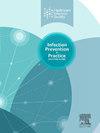二氧化碳浓度测试作为初级卫生保健自然通风有效性的快速估计:在受战争影响、资源有限的环境中的经验
IF 1.9
Q3 INFECTIOUS DISEASES
引用次数: 0
摘要
通风仍然是感染预防和控制规划的重要组成部分。自然通风作为控制病原体空气传播最经济实惠的措施,是一个关键的重点领域。然而,在日常实践中,特别是在紧急情况下,应用自然通风遇到了挑战。这项研究旨在审查最有效的自然通风方案,于2023年秋季在乌克兰两个受战争严重影响的初级保健机构进行。该研究证明了一种建立在简单方法之上的方案的操作优势,即人员只有在观察到二氧化碳浓度增加后才打开窗户。这种解决方案有明显的缺点,是被动的而不是主动的,并且需要连续监测二氧化碳浓度;事实证明,考虑到通风率和工作量,繁忙的医护人员比为每个办公室制定明确的方案更容易接受。病人抱怨在办公室里感到寒冷,这可能是正式使用自然通风的一个重大障碍。报告的结果被认为是启动自然通风政策的可接受的临时妥协。进一步的改进将需要人员培训和提高患者对空气传播病原体的合理预防干预措施的认识。本文章由计算机程序翻译,如有差异,请以英文原文为准。
CO2 concentration testing as a quick estimate of natural ventilation effectiveness in primary healthcare: experience in war-affected, resource-limited settings
Ventilation remains an important component of infection prevention and control programmes. Natural ventilation, as the most affordable measure to control airborne transmission of pathogens, is a crucial area of focus. However, applying natural ventilation encounters challenges in routine practice, especially in emergencies. This study, which aimed to review the most efficient natural ventilation regimen, was performed in Autumn 2023 in two heavily war-affected primary care facilities in Ukraine. The study demonstrated the operational advantage of a regimen built upon a simple approach, where personnel opened windows only after observing an increased CO2 concentration. This solution has obvious disadvantages, being reactive rather than proactive and requiring continuous monitoring of CO2 concentration; it turned out to be more acceptable to busy healthcare workers than regimens developed explicitly for each office, considering ventilation rate and workload. Patients' complaints about feeling cold in the offices may be a substantial obstacle to the formal use of natural ventilation. Reported results were considered an acceptable temporary compromise for initiating a natural ventilation policy. Further improvement will require personnel training and raising awareness about reasonable prevention interventions for airborne pathogens among patients.
求助全文
通过发布文献求助,成功后即可免费获取论文全文。
去求助
来源期刊

Infection Prevention in Practice
Medicine-Public Health, Environmental and Occupational Health
CiteScore
4.80
自引率
0.00%
发文量
58
审稿时长
61 days
 求助内容:
求助内容: 应助结果提醒方式:
应助结果提醒方式:


